false 0001759138 0001759138 2024-10-07 2024-10-07
UNITED STATES
SECURITIES AND EXCHANGE COMMISSION
Washington, D.C. 20549
FORM 8-K
CURRENT REPORT
Pursuant to Section 13 or 15(d)
of The Securities Exchange Act of 1934
October 7, 2024
Date of Report (Date of earliest event reported)
CABALETTA BIO, INC.
(Exact name of Registrant as Specified in its Charter)
|
|
|
|
|
| Delaware |
|
001-39103 |
|
82-1685768 |
(State or other jurisdiction
of incorporation) |
|
(Commission
File Number) |
|
(I.R.S. Employer
Identification No.) |
|
|
|
| 2929 Arch Street, Suite 600, Philadelphia, PA |
|
19104 |
| (Address of principal executive offices) |
|
(Zip Code) |
(267) 759-3100
(Registrant’s telephone number, including area code)
Not Applicable
(Former name or former address, if changed since last report)
Check the appropriate box below if the Form 8-K filing is intended to simultaneously satisfy the filing obligation of the registrant under any of the following provisions:
| ☐ |
Written communications pursuant to Rule 425 under the Securities Act (17 CFR 230.425) |
| ☐ |
Soliciting material pursuant to Rule 14a-12 under the Exchange Act (17 CFR 240.14a-12) |
| ☐ |
Pre-commencement communications pursuant to Rule 14d-2(b) under the Exchange Act (17 CFR 240.14d-2(b)) |
| ☐ |
Pre-commencement communications pursuant to Rule 13e-4(c) under the Exchange Act (17 CFR 240.13e-4(c)) |
Securities registered pursuant to Section 12(b) of the Act:
|
|
|
|
|
| Title of Each Class |
|
Trading
Symbol(s) |
|
Name of Each Exchange on Which Registered |
| Common Stock, par value $0.00001 per share |
|
CABA |
|
The Nasdaq Global Select Market |
Indicate by check mark whether the registrant is an emerging growth company as defined in Rule 405 of the Securities Act of 1933 (§230.405 of this chapter) or Rule 12b-2 of the Securities Exchange Act of 1934 (§240.12b-2 of this chapter).
Emerging growth company ☒
If an emerging growth company, indicate by check mark if the registrant has elected not to use the extended transition period for complying with any new or revised financial accounting standards provided pursuant to Section 13(a) of the Exchange Act. ☐
| Item 7.01 |
Regulation FD Disclosure. |
On October 7, 2024, Cabaletta Bio, Inc. (the “Company” or “Cabaletta”) posted to the “Investors & Media” section of the Company’s website at www.cabalettabio.com an updated corporate presentation providing a corporate overview and updated development plan (the “Corporate Presentation”). A copy of the Corporate Presentation is attached hereto as Exhibit 99.1 and is incorporated by reference into this Item 7.01 of this Current Report on Form 8-K.
The information contained in Item 7.01 of this Current Report on Form 8-K, including Exhibit 99.1 attached hereto, is being furnished and shall not be deemed to be “filed” for the purposes of Section 18 of the Securities Exchange Act of 1934, as amended (the “Exchange Act”), or otherwise subject to the liabilities of that section and shall not be incorporated by reference in any filing under the Securities Act of 1933, as amended, or the Exchange Act, except as shall be expressly set forth by specific reference in such filing.
On October 7, 2024, the Company issued an updated corporate presentation providing additional clarity on its upcoming milestones, including that additional clinical data from the RESET-SLE and RESET-Myositis trials along with initial clinical data from the RESET-SSc trial will be presented at the American College of Rheumatology Convergence 2024 Meeting in November 2024. Initial clinical data from the RESET-MG trial is anticipated in the first half of 2025.
Forward Looking Statements
The information under this Item 8.01 contains “forward-looking statements” of the Company within the meaning of the Private Securities Litigation Reform Act of 1995, as amended, including without limitation, express or implied statements regarding expectations regarding the upcoming data milestones. Any forward-looking statements in this Item 8.01 are based on management’s current expectations and beliefs of future events, and are subject to a number of risks and uncertainties that could cause actual results to differ materially and adversely from those set forth in or implied by such forward-looking statements. For a discussion of these and other risks and uncertainties, and other important factors, any of which could cause the Company’s actual results to differ from those contained in the forward-looking statements, see the section entitled “Risk Factors” in the Company’s most recent annual report on Form 10-K as well as discussions of potential risks, uncertainties, and other important factors in the Company’s other and subsequent filings with the Securities and Exchange Commission. All information in this Item 8.01 is as of the date of this Current Report on Form 8-K, and the Company undertakes no duty to update this information unless required by law.
| Item 9.01 |
Financial Statements and Exhibits. |
(d) Exhibits
SIGNATURE
Pursuant to the requirements of the Securities Exchange Act of 1934, as amended, the registrant has duly caused this report to be signed on its behalf by the undersigned, hereunto duly authorized.
|
|
|
|
|
|
|
|
|
|
|
CABALETTA BIO, INC. |
|
|
|
|
| Date: October 7, 2024 |
|
|
|
By: |
|
/s/ Steven Nichtberger |
|
|
|
|
|
|
Steven Nichtberger, M.D. |
|
|
|
|
|
|
President and Chief Executive Officer |

Corporate Presentation OCTOBER 2024
Exhibit 99.1
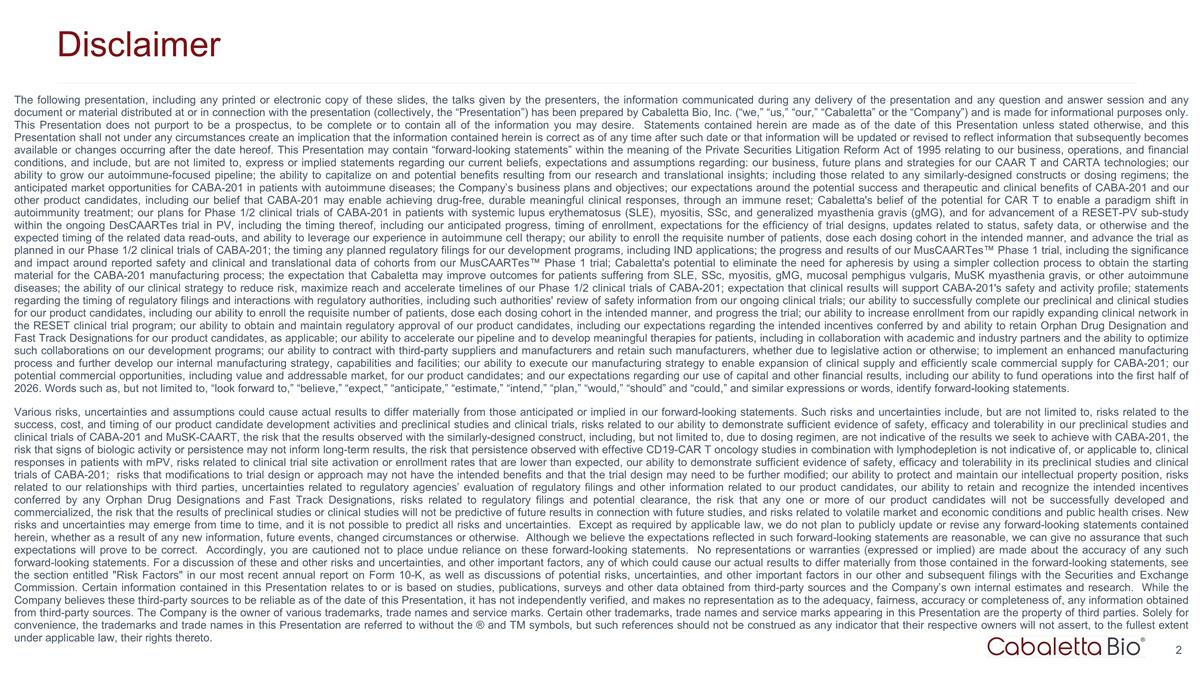
Disclaimer The following presentation,
including any printed or electronic copy of these slides, the talks given by the presenters, the information communicated during any delivery of the presentation and any question and answer session and any document or material distributed at or in
connection with the presentation (collectively, the “Presentation”) has been prepared by Cabaletta Bio, Inc. (“we,” “us,” “our,” “Cabaletta” or the “Company”) and is made for
informational purposes only. This Presentation does not purport to be a prospectus, to be complete or to contain all of the information you may desire. Statements contained herein are made as of the date of this Presentation unless stated otherwise,
and this Presentation shall not under any circumstances create an implication that the information contained herein is correct as of any time after such date or that information will be updated or revised to reflect information that subsequently
becomes available or changes occurring after the date hereof. This Presentation may contain “forward-looking statements” within the meaning of the Private Securities Litigation Reform Act of 1995 relating to our business, operations, and
financial conditions, and include, but are not limited to, express or implied statements regarding our current beliefs, expectations and assumptions regarding: our business, future plans and strategies for our CAAR T and CARTA technologies; our
ability to grow our autoimmune-focused pipeline; the ability to capitalize on and potential benefits resulting from our research and translational insights; including those related to any similarly-designed constructs or dosing regimens; the
anticipated market opportunities for CABA-201 in patients with autoimmune diseases; the Company’s business plans and objectives; our expectations around the potential success and therapeutic and clinical benefits of CABA-201 and our other
product candidates, including our belief that CABA-201 may enable achieving drug-free, durable meaningful clinical responses, through an immune reset; Cabaletta's belief of the potential for CAR T to enable a paradigm shift in autoimmunity
treatment; our plans for Phase 1/2 clinical trials of CABA-201 in patients with systemic lupus erythematosus (SLE), myositis, SSc, and generalized myasthenia gravis (gMG), and for advancement of a RESET-PV sub-study within the ongoing DesCAARTes
trial in PV, including the timing thereof, including our anticipated progress, timing of enrollment, expectations for the efficiency of trial designs, updates related to status, safety data, or otherwise and the expected timing of the related data
read-outs, and ability to leverage our experience in autoimmune cell therapy; our ability to enroll the requisite number of patients, dose each dosing cohort in the intended manner, and advance the trial as planned in our Phase 1/2 clinical trials
of CABA-201; the timing any planned regulatory filings for our development programs, including IND applications; the progress and results of our MusCAARTes™ Phase 1 trial, including the significance and impact around reported safety and
clinical and translational data of cohorts from our MusCAARTes™ Phase 1 trial; Cabaletta's potential to eliminate the need for apheresis by using a simpler collection process to obtain the starting material for the CABA-201 manufacturing
process; the expectation that Cabaletta may improve outcomes for patients suffering from SLE, SSc, myositis, gMG, mucosal pemphigus vulgaris, MuSK myasthenia gravis, or other autoimmune diseases; the ability of our clinical strategy to reduce risk,
maximize reach and accelerate timelines of our Phase 1/2 clinical trials of CABA-201; expectation that clinical results will support CABA-201's safety and activity profile; statements regarding the timing of regulatory filings and interactions with
regulatory authorities, including such authorities' review of safety information from our ongoing clinical trials; our ability to successfully complete our preclinical and clinical studies for our product candidates, including our ability to enroll
the requisite number of patients, dose each dosing cohort in the intended manner, and progress the trial; our ability to increase enrollment from our rapidly expanding clinical network in the RESET clinical trial program; our ability to obtain and
maintain regulatory approval of our product candidates, including our expectations regarding the intended incentives conferred by and ability to retain Orphan Drug Designation and Fast Track Designations for our product candidates, as applicable;
our ability to accelerate our pipeline and to develop meaningful therapies for patients, including in collaboration with academic and industry partners and the ability to optimize such collaborations on our development programs; our ability to
contract with third-party suppliers and manufacturers and retain such manufacturers, whether due to legislative action or otherwise; to implement an enhanced manufacturing process and further develop our internal manufacturing strategy, capabilities
and facilities; our ability to execute our manufacturing strategy to enable expansion of clinical supply and efficiently scale commercial supply for CABA-201; our potential commercial opportunities, including value and addressable market, for our
product candidates; and our expectations regarding our use of capital and other financial results, including our ability to fund operations into the first half of 2026. Words such as, but not limited to, “look forward to,”
“believe,” “expect,” “anticipate,” “estimate,” “intend,” “plan,” “would,” “should” and “could,” and similar expressions or words, identify
forward-looking statements. Various risks, uncertainties and assumptions could cause actual results to differ materially from those anticipated or implied in our forward-looking statements. Such risks and uncertainties include, but are not limited
to, risks related to the success, cost, and timing of our product candidate development activities and preclinical studies and clinical trials, risks related to our ability to demonstrate sufficient evidence of safety, efficacy and tolerability in
our preclinical studies and clinical trials of CABA-201 and MuSK-CAART, the risk that the results observed with the similarly-designed construct, including, but not limited to, due to dosing regimen, are not indicative of the results we seek to
achieve with CABA-201, the risk that signs of biologic activity or persistence may not inform long-term results, the risk that persistence observed with effective CD19-CAR T oncology studies in combination with lymphodepletion is not indicative of,
or applicable to, clinical responses in patients with mPV, risks related to clinical trial site activation or enrollment rates that are lower than expected, our ability to demonstrate sufficient evidence of safety, efficacy and tolerability in its
preclinical studies and clinical trials of CABA-201; risks that modifications to trial design or approach may not have the intended benefits and that the trial design may need to be further modified; our ability to protect and maintain our
intellectual property position, risks related to our relationships with third parties, uncertainties related to regulatory agencies’ evaluation of regulatory filings and other information related to our product candidates, our ability to
retain and recognize the intended incentives conferred by any Orphan Drug Designations and Fast Track Designations, risks related to regulatory filings and potential clearance, the risk that any one or more of our product candidates will not be
successfully developed and commercialized, the risk that the results of preclinical studies or clinical studies will not be predictive of future results in connection with future studies, and risks related to volatile market and economic conditions
and public health crises. New risks and uncertainties may emerge from time to time, and it is not possible to predict all risks and uncertainties. Except as required by applicable law, we do not plan to publicly update or revise any forward-looking
statements contained herein, whether as a result of any new information, future events, changed circumstances or otherwise. Although we believe the expectations reflected in such forward-looking statements are reasonable, we can give no assurance
that such expectations will prove to be correct. Accordingly, you are cautioned not to place undue reliance on these forward-looking statements. No representations or warranties (expressed or implied) are made about the accuracy of any such
forward-looking statements. For a discussion of these and other risks and uncertainties, and other important factors, any of which could cause our actual results to differ materially from those contained in the forward-looking statements, see the
section entitled "Risk Factors" in our most recent annual report on Form 10-K, as well as discussions of potential risks, uncertainties, and other important factors in our other and subsequent filings with the Securities and Exchange Commission.
Certain information contained in this Presentation relates to or is based on studies, publications, surveys and other data obtained from third-party sources and the Company’s own internal estimates and research. While the Company believes
these third-party sources to be reliable as of the date of this Presentation, it has not independently verified, and makes no representation as to the adequacy, fairness, accuracy or completeness of, any information obtained from third-party
sources. The Company is the owner of various trademarks, trade names and service marks. Certain other trademarks, trade names and service marks appearing in this Presentation are the property of third parties. Solely for convenience, the trademarks
and trade names in this Presentation are referred to without the ® and TM symbols, but such references should not be construed as any indicator that their respective owners will not assert, to the fullest extent under applicable law, their
rights thereto.

Develop and launch the first curative
targeted cellular therapies for patients with autoimmune diseases
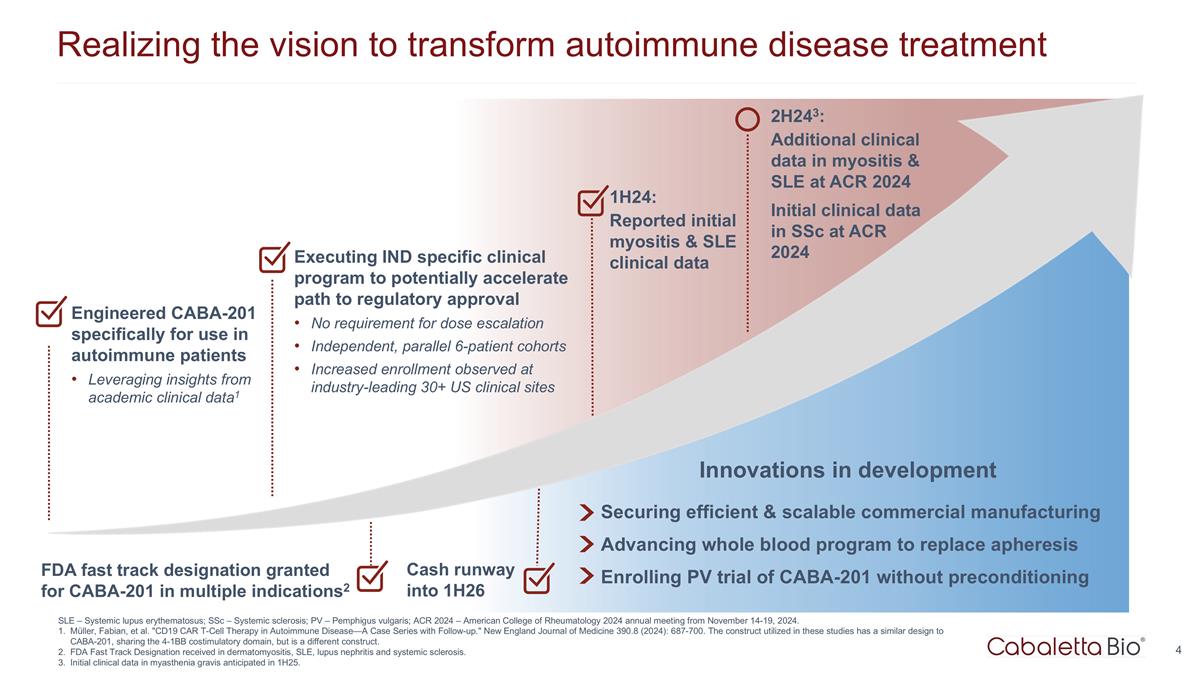
Realizing the vision to transform
autoimmune disease treatment 1H24: Reported initial myositis & SLE clinical data Securing efficient & scalable commercial manufacturing Advancing whole blood program to replace apheresis Enrolling PV trial of CABA-201 without preconditioning
Cash runway into 1H26 Engineered CABA-201 specifically for use in autoimmune patients Leveraging insights from academic clinical data1 Executing IND specific clinical program to potentially accelerate path to regulatory approval No requirement for
dose escalation Independent, parallel 6-patient cohorts Increased enrollment observed at industry-leading 30+ US clinical sites 2H243: Additional clinical data in myositis & SLE at ACR 2024 Initial clinical data in SSc at ACR 2024 FDA fast track
designation granted for CABA-201 in multiple indications2 SLE – Systemic lupus erythematosus; SSc – Systemic sclerosis; PV – Pemphigus vulgaris; ACR 2024 – American College of Rheumatology 2024 annual meeting from November
14-19, 2024. Müller, Fabian, et al. "CD19 CAR T-Cell Therapy in Autoimmune Disease—A Case Series with Follow-up." New England Journal of Medicine 390.8 (2024): 687-700. The construct utilized in these studies has a similar design to
CABA-201, sharing the 4-1BB costimulatory domain, but is a different construct. FDA Fast Track Designation received in dermatomyositis, SLE, lupus nephritis and systemic sclerosis. Initial clinical data in myasthenia gravis anticipated in 1H25.
Innovations in development
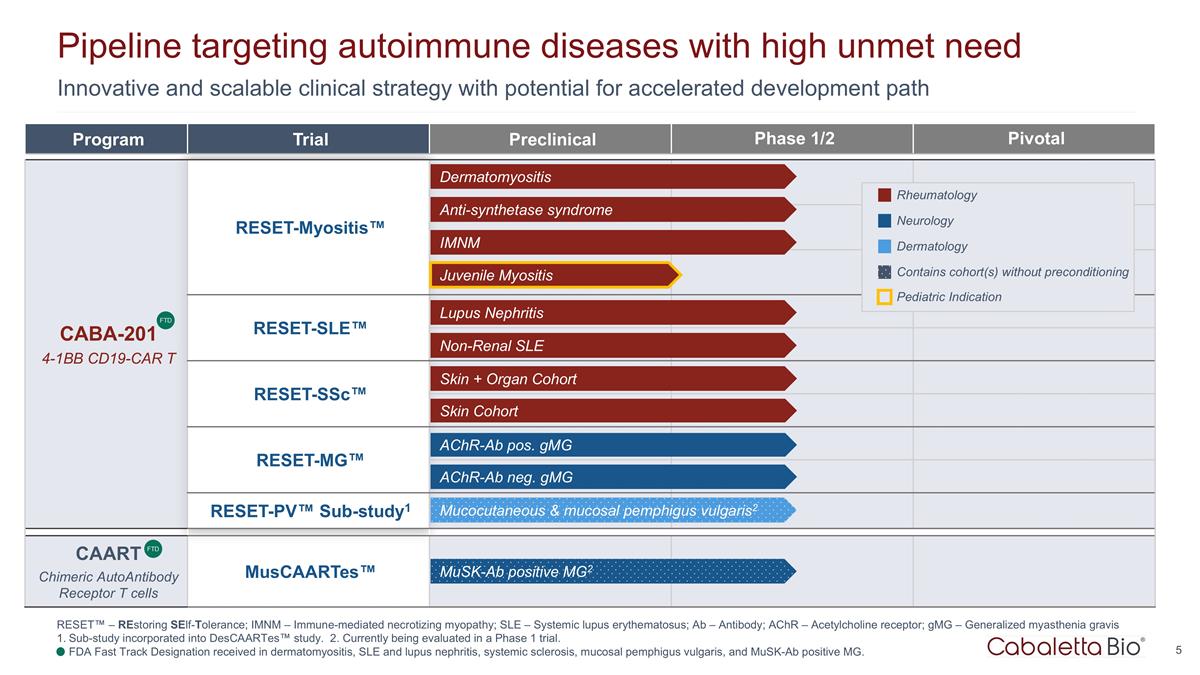
Innovative and scalable clinical
strategy with potential for accelerated development path Pipeline targeting autoimmune diseases with high unmet need Program Trial Preclinical Phase 1/2 Pivotal CABA-201 4-1BB CD19-CAR T RESET-Myositis™ CARTA Chimeric Antigen Receptor T cells
for Autoimmunity RESET-SLE™ RESET-SSc™ RESET-MG™ RESET-PV™ Sub-study1 CAART Chimeric AutoAntibody Receptor T cells MusCAARTes™ Dermatomyositis Anti-synthetase syndrome IMNM Lupus Nephritis Non-Renal SLE Skin + Organ
Cohort AChR-Ab neg. gMG AChR-Ab pos. gMG Skin Cohort Rheumatology Neurology Dermatology FTD Mucocutaneous & mucosal pemphigus vulgaris2 Contains cohort(s) without preconditioning Juvenile Myositis Pediatric Indication MuSK-Ab positive MG2 FTD
RESET™ – REstoring SElf-Tolerance; IMNM – Immune-mediated necrotizing myopathy; SLE – Systemic lupus erythematosus; Ab – Antibody; AChR – Acetylcholine receptor; gMG – Generalized myasthenia gravis Sub-study
incorporated into DesCAARTes™ study. 2. Currently being evaluated in a Phase 1 trial. FDA Fast Track Designation received in dermatomyositis, SLE and lupus nephritis, systemic sclerosis, mucosal pemphigus vulgaris, and MuSK-Ab positive MG.

Chimeric Antigen Receptor T Cells for
Autoimmunity CABA-201
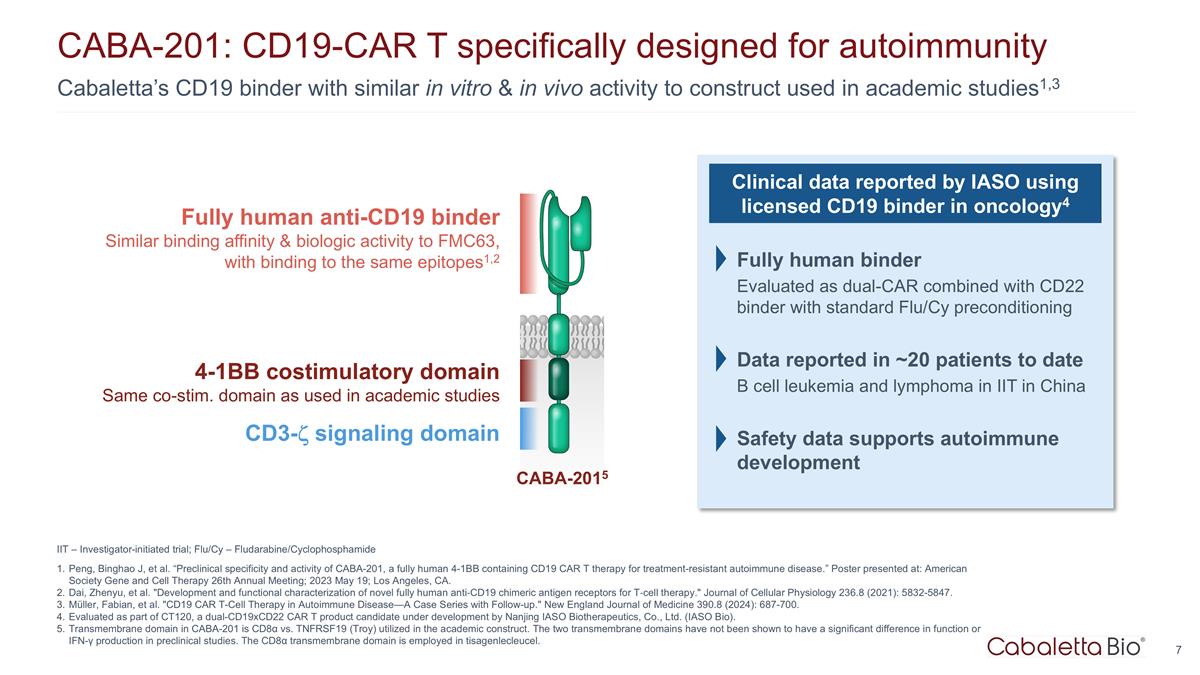
Cabaletta’s CD19 binder with
similar in vitro & in vivo activity to construct used in academic studies1,3 CABA-201: CD19-CAR T specifically designed for autoimmunity IIT – Investigator-initiated trial; Flu/Cy – Fludarabine/Cyclophosphamide Peng, Binghao J, et
al. “Preclinical specificity and activity of CABA-201, a fully human 4-1BB containing CD19 CAR T therapy for treatment-resistant autoimmune disease.” Poster presented at: American Society Gene and Cell Therapy 26th Annual Meeting; 2023
May 19; Los Angeles, CA. Dai, Zhenyu, et al. "Development and functional characterization of novel fully human anti‐CD19 chimeric antigen receptors for T‐cell therapy." Journal of Cellular Physiology 236.8 (2021): 5832-5847. Müller,
Fabian, et al. "CD19 CAR T-Cell Therapy in Autoimmune Disease—A Case Series with Follow-up." New England Journal of Medicine 390.8 (2024): 687-700. Evaluated as part of CT120, a dual-CD19xCD22 CAR T product candidate under development by
Nanjing IASO Biotherapeutics, Co., Ltd. (IASO Bio). Transmembrane domain in CABA-201 is CD8α vs. TNFRSF19 (Troy) utilized in the academic construct. The two transmembrane domains have not been shown to have a significant difference in function
or IFN-γ production in preclinical studies. The CD8α transmembrane domain is employed in tisagenlecleucel. Clinical data reported by IASO using licensed CD19 binder in oncology4 Fully human binder Evaluated as dual-CAR combined with CD22
binder with standard Flu/Cy preconditioning Data reported in ~20 patients to date B cell leukemia and lymphoma in IIT in China Safety data supports autoimmune development Fully human anti-CD19 binder Similar binding affinity & biologic activity
to FMC63, with binding to the same epitopes1,2 4-1BB costimulatory domain Same co-stim. domain as used in academic studies CD3-z signaling domain CABA-2015
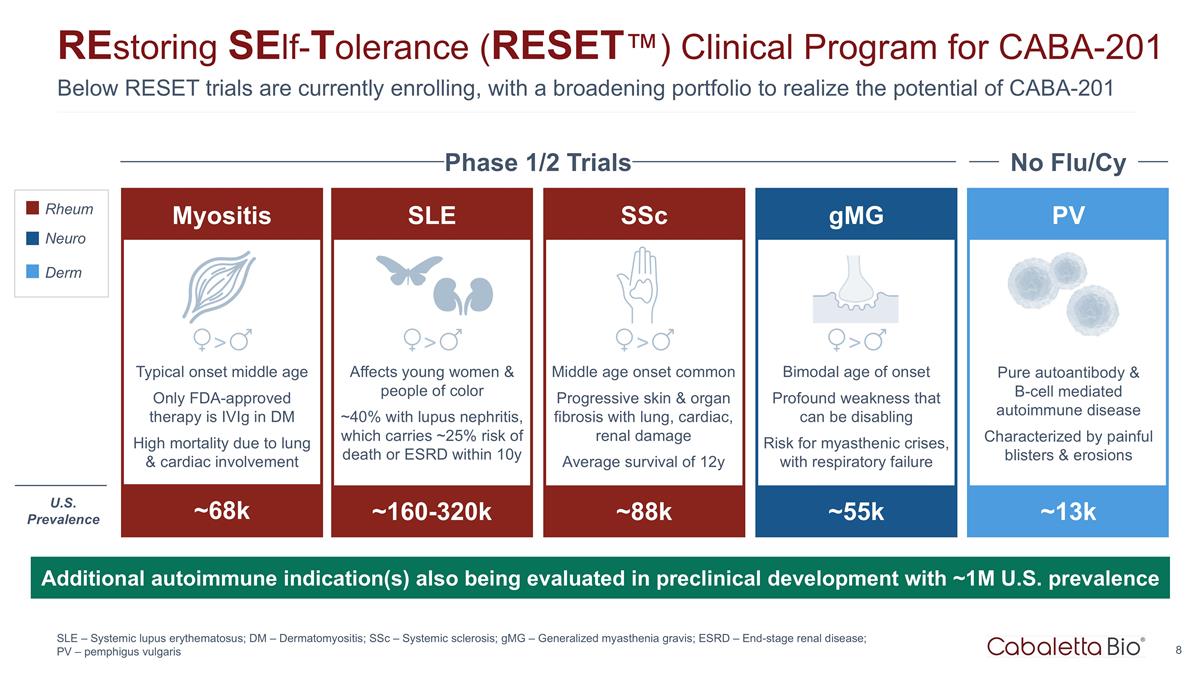
Below RESET trials are currently
enrolling, with a broadening portfolio to realize the potential of CABA-201 REstoring SElf-Tolerance (RESET™) Clinical Program for CABA-201 SLE – Systemic lupus erythematosus; DM – Dermatomyositis; SSc – Systemic sclerosis;
gMG – Generalized myasthenia gravis; ESRD – End-stage renal disease; PV – pemphigus vulgaris Additional autoimmune indication(s) also being evaluated in preclinical development with ~1M U.S. prevalence SSc gMG PV ~88k ~55k ~13k
Middle age onset common Progressive skin & organ fibrosis with lung, cardiac, renal damage Average survival of 12y Bimodal age of onset Profound weakness that can be disabling Risk for myasthenic crises, with respiratory failure Phase 1/2 Trials
Rheum Neuro Derm U.S. Prevalence No Flu/Cy Pure autoantibody & B-cell mediated autoimmune disease Characterized by painful blisters & erosions SLE ~160-320k Affects young women & people of color ~40% with lupus nephritis, which carries
~25% risk of death or ESRD within 10y > > > Myositis ~68k Typical onset middle age Only FDA-approved therapy is IVIg in DM High mortality due to lung & cardiac involvement >
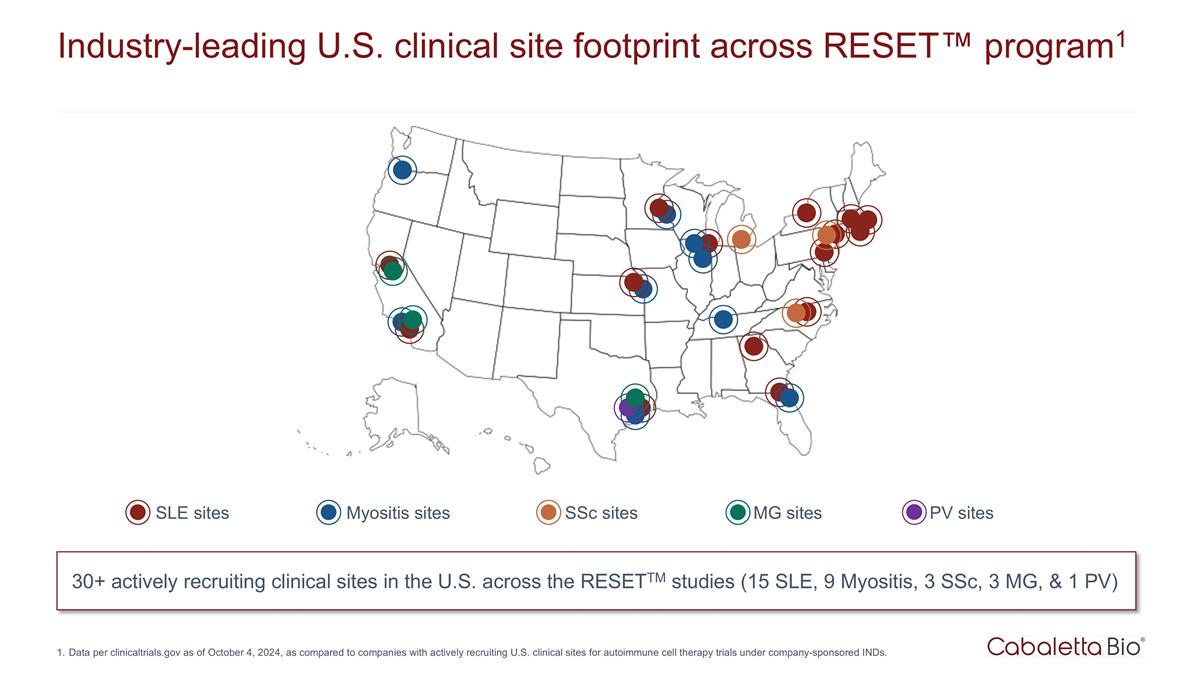
Industry-leading U.S. clinical site
footprint across RESET™ program1 Data per clinicaltrials.gov as of October 4, 2024, as compared to companies with actively recruiting U.S. clinical sites for autoimmune cell therapy trials under company-sponsored INDs. 30+ actively recruiting
clinical sites in the U.S. across the RESETTM studies (15 SLE, 9 Myositis, 3 SSc, 3 MG, & 1 PV) SLE sites Myositis sites SSc sites MG sites PV sites
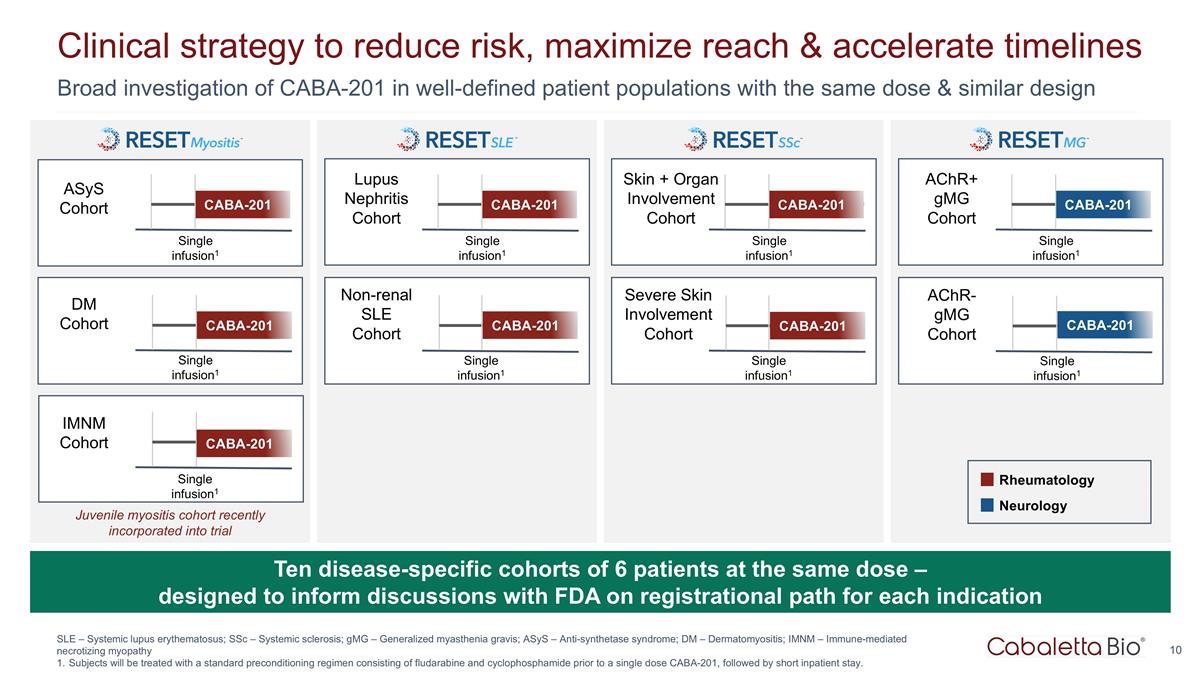
Broad investigation of CABA-201 in
well-defined patient populations with the same dose & similar design Clinical strategy to reduce risk, maximize reach & accelerate timelines SLE – Systemic lupus erythematosus; SSc – Systemic sclerosis; gMG – Generalized
myasthenia gravis; ASyS – Anti-synthetase syndrome; DM – Dermatomyositis; IMNM – Immune-mediated necrotizing myopathy Subjects will be treated with a standard preconditioning regimen consisting of fludarabine and cyclophosphamide
prior to a single dose CABA-201, followed by short inpatient stay. Ten disease-specific cohorts of 6 patients at the same dose – designed to inform discussions with FDA on registrational path for each indication ASyS Cohort Single infusion1
CABA-201 IMNM Cohort Single infusion1 DM Cohort Skin + Organ Involvement Cohort CABA-201 AChR+ gMG Cohort CABA-201 Lupus Nephritis Cohort CABA-201 Non-renal SLE Cohort Severe Skin Involvement Cohort AChR- gMG Cohort Single infusion1 Single infusion1
Single infusion1 Single infusion1 Single infusion1 Single infusion1 Single infusion1 CABA-201 Juvenile myositis cohort recently incorporated into trial CABA-201 CABA-201 CABA-201 CABA-201 Rheumatology Neurology
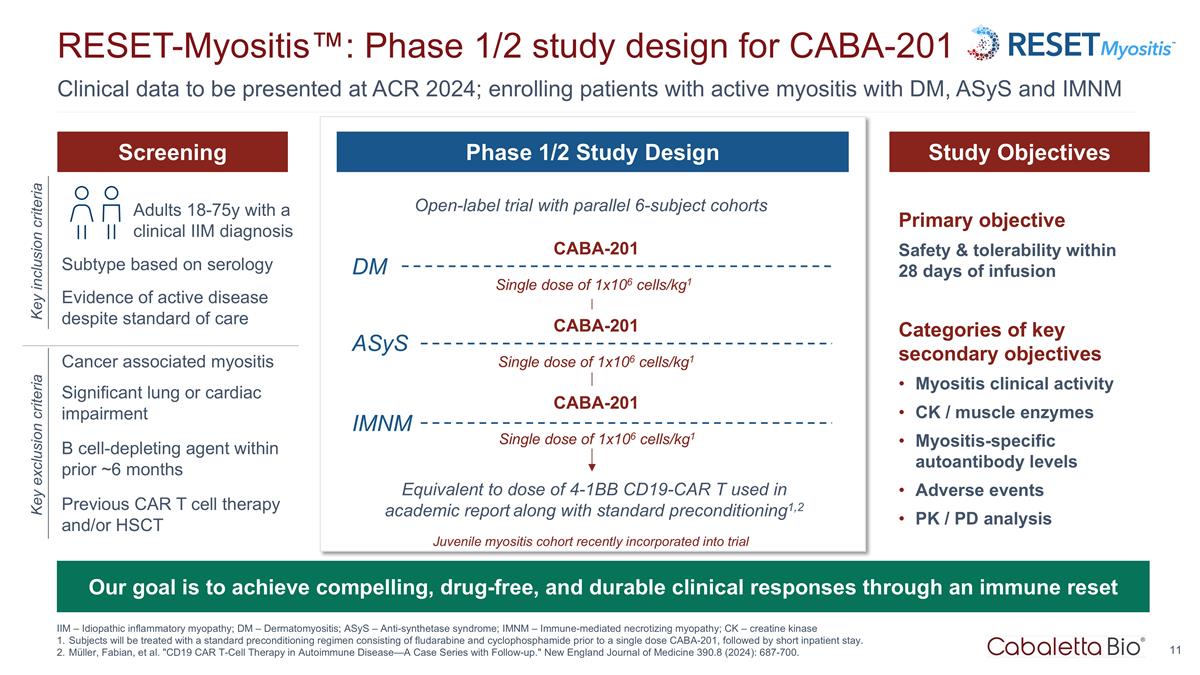
Clinical data to be presented at
ACR 2024; enrolling patients with active myositis with DM, ASyS and IMNM RESET-Myositis™: Phase 1/2 study design for CABA-201 IIM – Idiopathic inflammatory myopathy; DM – Dermatomyositis; ASyS – Anti-synthetase syndrome; IMNM
– Immune-mediated necrotizing myopathy; CK – creatine kinase Subjects will be treated with a standard preconditioning regimen consisting of fludarabine and cyclophosphamide prior to a single dose CABA-201, followed by short inpatient
stay. Müller, Fabian, et al. "CD19 CAR T-Cell Therapy in Autoimmune Disease—A Case Series with Follow-up." New England Journal of Medicine 390.8 (2024): 687-700. ASyS B cell-depleting agent within prior ~6 months Primary objective Safety
& tolerability within 28 days of infusion Categories of key secondary objectives Myositis clinical activity CK / muscle enzymes Myositis-specific autoantibody levels Adverse events PK / PD analysis Open-label trial with parallel 6-subject
cohorts Equivalent to dose of 4-1BB CD19-CAR T used in academic report along with standard preconditioning1,2 Screening Study Objectives Phase 1/2 Study Design Evidence of active disease despite standard of care Key inclusion criteria Cancer
associated myositis Key exclusion criteria Significant lung or cardiac impairment Adults 18-75y with a clinical IIM diagnosis Single dose of 1x106 cells/kg1 CABA-201 Single dose of 1x106 cells/kg1 CABA-201 Single dose of 1x106 cells/kg1 CABA-201 DM
IMNM Previous CAR T cell therapy and/or HSCT Subtype based on serology Our goal is to achieve compelling, drug-free, and durable clinical responses through an immune reset Juvenile myositis cohort recently incorporated into trial
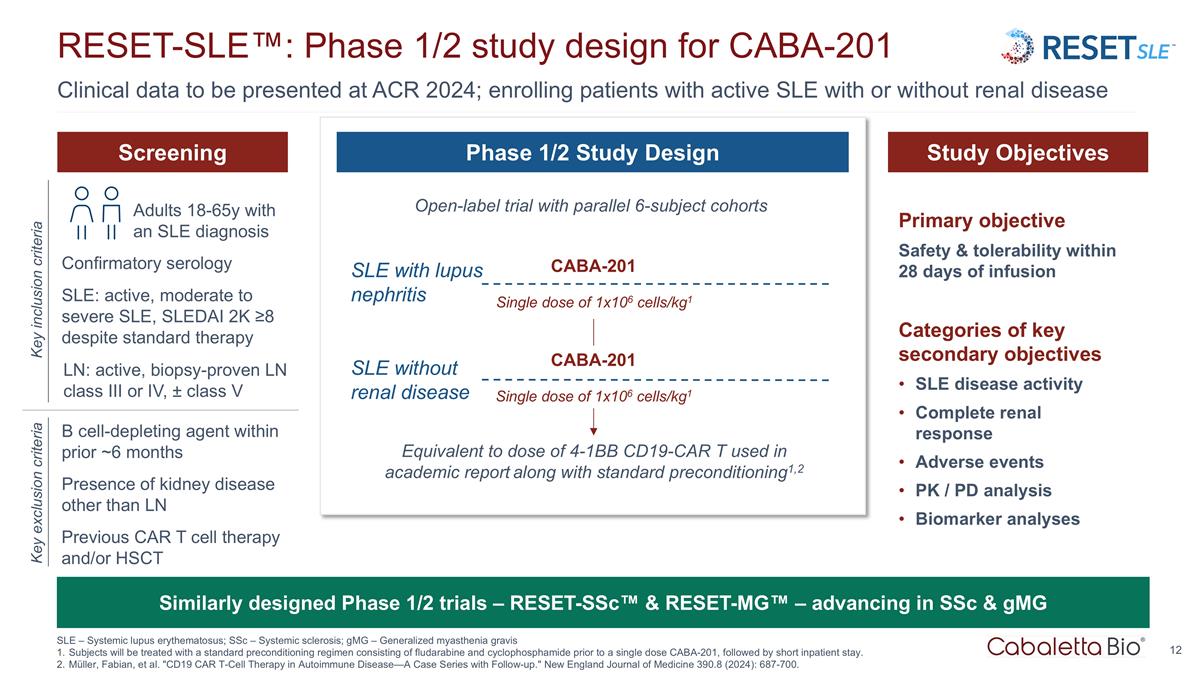
Clinical data to be presented at
ACR 2024; enrolling patients with active SLE with or without renal disease RESET-SLE™: Phase 1/2 study design for CABA-201 SLE – Systemic lupus erythematosus; SSc – Systemic sclerosis; gMG – Generalized myasthenia gravis
Subjects will be treated with a standard preconditioning regimen consisting of fludarabine and cyclophosphamide prior to a single dose CABA-201, followed by short inpatient stay. Müller, Fabian, et al. "CD19 CAR T-Cell Therapy in Autoimmune
Disease—A Case Series with Follow-up." New England Journal of Medicine 390.8 (2024): 687-700. SLE with lupus nephritis SLE without renal disease Open-label trial with parallel 6-subject cohorts Equivalent to dose of 4-1BB CD19-CAR T used in
academic report along with standard preconditioning1,2 Screening Study Objectives Phase 1/2 Study Design Confirmatory serology B cell-depleting agent within prior ~6 months SLE: active, moderate to severe SLE, SLEDAI 2K ≥8 despite standard
therapy Key inclusion criteria Presence of kidney disease other than LN Key exclusion criteria Single dose of 1x106 cells/kg1 CABA-201 Single dose of 1x106 cells/kg1 CABA-201 Adults 18-65y with an SLE diagnosis Primary objective Safety &
tolerability within 28 days of infusion Categories of key secondary objectives SLE disease activity Complete renal response Adverse events PK / PD analysis Biomarker analyses LN: active, biopsy-proven LN class III or IV, ± class V Previous CAR
T cell therapy and/or HSCT Similarly designed Phase 1/2 trials – RESET-SSc™ & RESET-MG™ – advancing in SSc & gMG
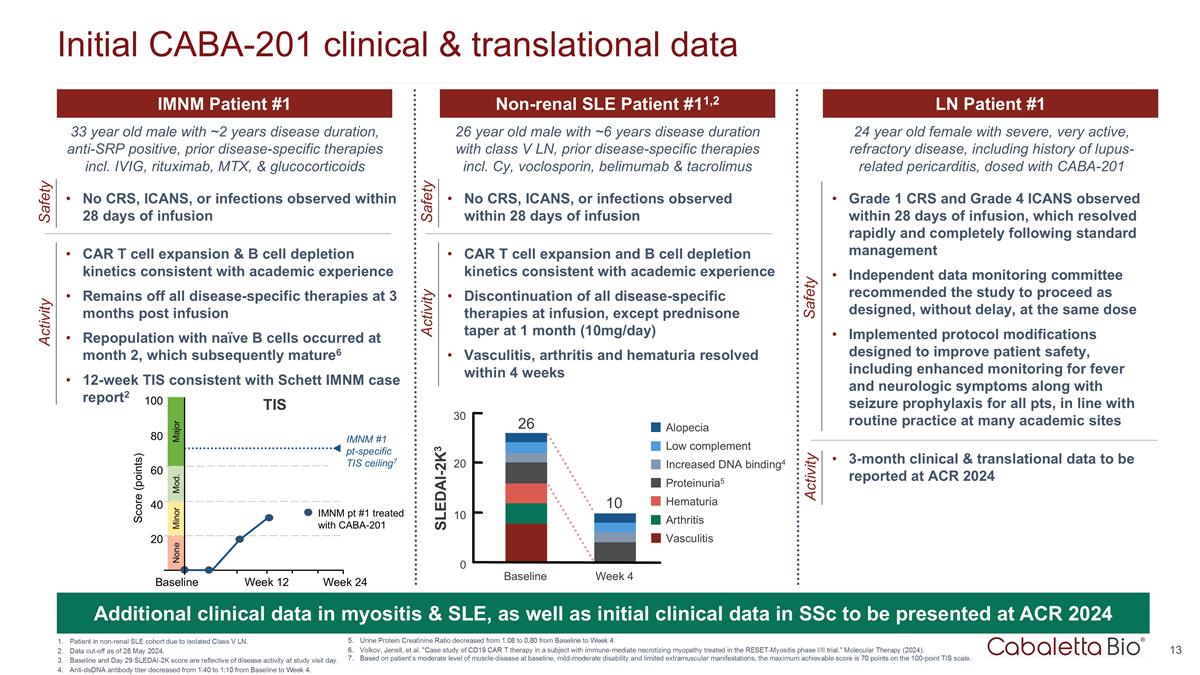
Initial CABA-201 clinical &
translational data IMNM Patient #1 Non-renal SLE Patient #11,2 LN Patient #1 No CRS, ICANS, or infections observed within 28 days of infusion CAR T cell expansion & B cell depletion kinetics consistent with academic experience Remains off all
disease-specific therapies at 3 months post infusion Repopulation with naïve B cells occurred at month 2, which subsequently mature6 12-week TIS consistent with Schett IMNM case report2 No CRS, ICANS, or infections observed within 28 days of
infusion CAR T cell expansion and B cell depletion kinetics consistent with academic experience Discontinuation of all disease-specific therapies at infusion, except prednisone taper at 1 month (10mg/day) Vasculitis, arthritis and hematuria resolved
within 4 weeks Grade 1 CRS and Grade 4 ICANS observed within 28 days of infusion, which resolved rapidly and completely following standard management Independent data monitoring committee recommended the study to proceed as designed, without delay,
at the same dose Implemented protocol modifications designed to improve patient safety, including enhanced monitoring for fever and neurologic symptoms along with seizure prophylaxis for all pts, in line with routine practice at many academic sites
3-month clinical & translational data to be reported at ACR 2024 Safety Activity Safety Activity Alopecia Low complement Increased DNA binding4 Proteinuria5 Hematuria Arthritis Vasculitis 26 10 20 SLEDAI-2K3 10 0 Baseline Week 4 30 Score
(points) 100 80 Minor Mod. 60 40 20 Week 24 Baseline Week 12 None IMNM #1 pt-specific TIS ceiling7 TIS IMNM pt #1 treated with CABA-201 Major Safety Activity 33 year old male with ~2 years disease duration, anti-SRP positive, prior disease-specific
therapies incl. IVIG, rituximab, MTX, & glucocorticoids 26 year old male with ~6 years disease duration with class V LN, prior disease-specific therapies incl. Cy, voclosporin, belimumab & tacrolimus 24 year old female with severe, very
active, refractory disease, including history of lupus-related pericarditis, dosed with CABA-201 Additional clinical data in myositis & SLE, as well as initial clinical data in SSc to be presented at ACR 2024 Patient in non-renal SLE cohort due
to isolated Class V LN. Data cut-off as of 28 May 2024. Baseline and Day 29 SLEDAI-2K score are reflective of disease activity at study visit day. Anti-dsDNA antibody titer decreased from 1:40 to 1:10 from Baseline to Week 4. Urine Protein
Creatinine Ratio decreased from 1.08 to 0.80 from Baseline to Week 4. Volkov, Jenell, et al. "Case study of CD19 CAR T therapy in a subject with immune-mediate necrotizing myopathy treated in the RESET-Myositis phase I/II trial." Molecular Therapy
(2024). Based on patient’s moderate level of muscle disease at baseline, mild-moderate disability and limited extramuscular manifestations, the maximum achievable score is 70 points on the 100-point TIS scale.
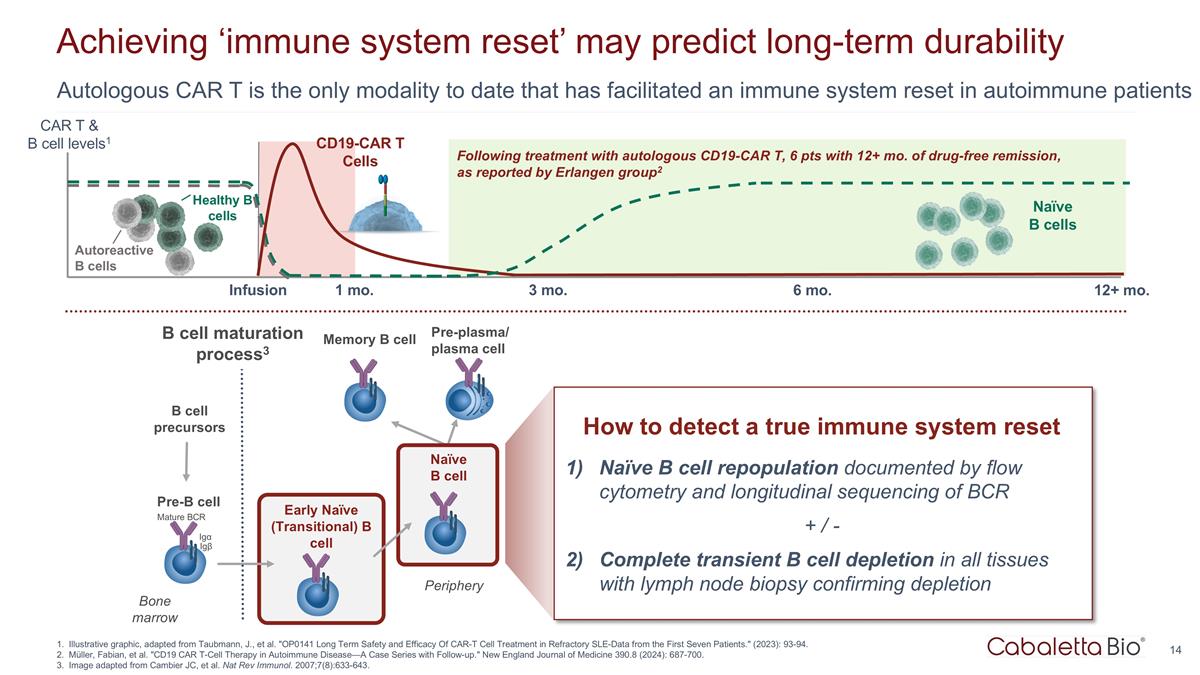
Autologous CAR T is the only
modality to date that has facilitated an immune system reset in autoimmune patients Achieving ‘immune system reset’ may predict long-term durability Illustrative graphic, adapted from Taubmann, J., et al. "OP0141 Long Term Safety and
Efficacy Of CAR-T Cell Treatment in Refractory SLE-Data from the First Seven Patients." (2023): 93-94. Müller, Fabian, et al. "CD19 CAR T-Cell Therapy in Autoimmune Disease—A Case Series with Follow-up." New England Journal of Medicine
390.8 (2024): 687-700. Image adapted from Cambier JC, et al. Nat Rev Immunol. 2007;7(8):633-643. Pre-B cell Early Naïve (Transitional) B cell Naïve B cell Mature BCR Igα Igβ Bone marrow Periphery B cell precursors Pre-plasma/
plasma cell B cell maturation process3 Memory B cell How to detect a true immune system reset Naïve B cell repopulation documented by flow cytometry and longitudinal sequencing of BCR + / - Complete transient B cell depletion in all tissues
with lymph node biopsy confirming depletion Following treatment with autologous CD19-CAR T, 6 pts with 12+ mo. of drug-free remission, as reported by Erlangen group2 Infusion 1 mo. 3 mo. 12+ mo. 6 mo. CD19-CAR T Cells Naïve B cells Healthy B
cells Autoreactive B cells CAR T & B cell levels1
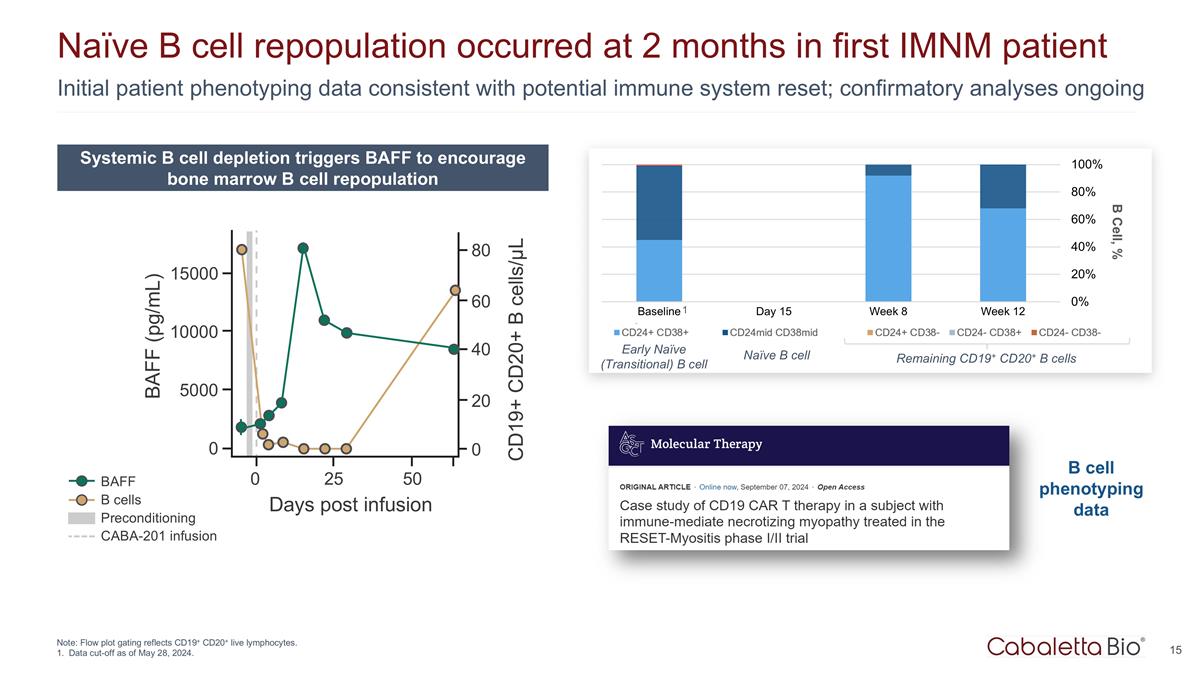
Initial patient phenotyping data
consistent with potential immune system reset; confirmatory analyses ongoing Naïve B cell repopulation occurred at 2 months in first IMNM patient Note: Flow plot gating reflects CD19+ CD20+ live lymphocytes. Data cut-off as of May 28, 2024. B
Cell, % B cell phenotyping data 1 Early Naïve (Transitional) B cell Naïve B cell Remaining CD19+ CD20+ B cells BAFF B cells Preconditioning CABA-201 infusion Systemic B cell depletion triggers BAFF to encourage bone marrow B cell
repopulation 15000 10000 5000 0 0 25 50 Days post infusion CD19+ CD20+ B cells/µL BAFF (pg/mL) 80 60 40 20 0

CABA-201 Product Candidate &
Process Innovations
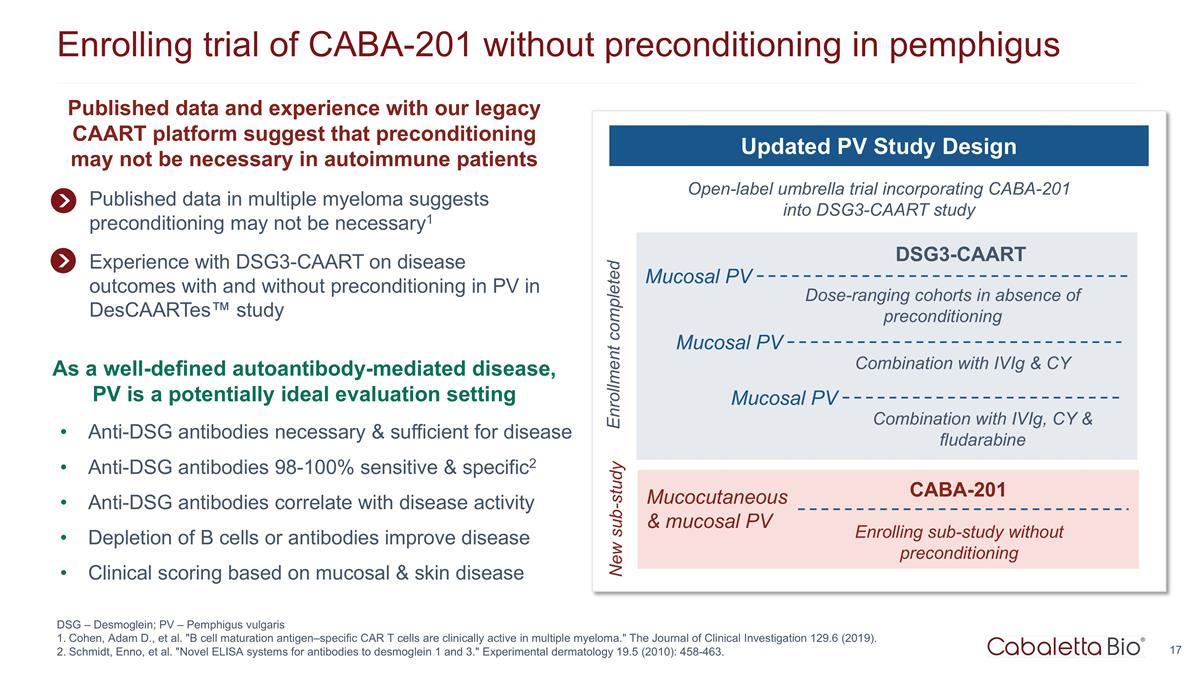
Enrolling trial of CABA-201 without
preconditioning in pemphigus DSG – Desmoglein; PV – Pemphigus vulgaris Cohen, Adam D., et al. "B cell maturation antigen–specific CAR T cells are clinically active in multiple myeloma." The Journal of Clinical
Investigation 129.6 (2019). Schmidt, Enno, et al. "Novel ELISA systems for antibodies to desmoglein 1 and 3." Experimental dermatology 19.5 (2010): 458-463. Published data in multiple myeloma suggests preconditioning may not be necessary1
Experience with DSG3-CAART on disease outcomes with and without preconditioning in PV in DesCAARTes™ study Open-label umbrella trial incorporating CABA-201 into DSG3-CAART study Updated PV Study Design Mucocutaneous & mucosal PV Enrolling
sub-study without preconditioning CABA-201 New sub-study As a well-defined autoantibody-mediated disease, PV is a potentially ideal evaluation setting Anti-DSG antibodies necessary & sufficient for disease Anti-DSG antibodies 98-100% sensitive
& specific2 Anti-DSG antibodies correlate with disease activity Depletion of B cells or antibodies improve disease Clinical scoring based on mucosal & skin disease Published data and experience with our legacy CAART platform suggest that
preconditioning may not be necessary in autoimmune patients Dose-ranging cohorts in absence of preconditioning DSG3-CAART Mucosal PV Combination with IVIg & CY Mucosal PV Combination with IVIg, CY & fludarabine Mucosal PV Enrollment
completed
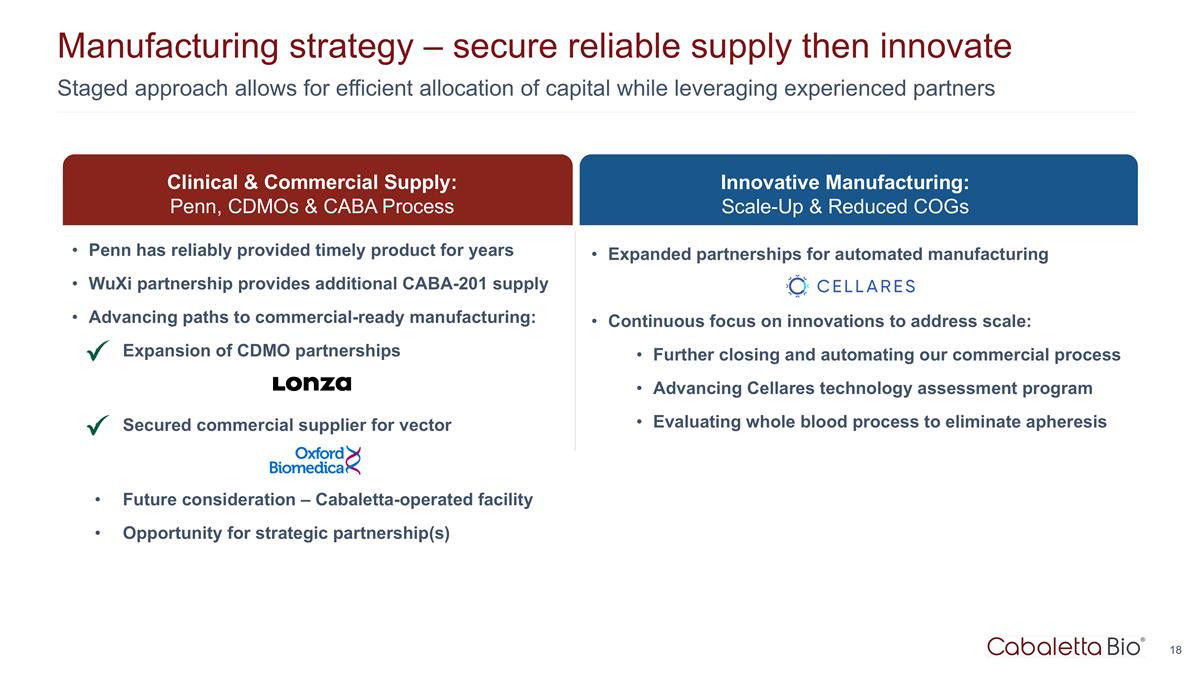
Staged approach allows for
efficient allocation of capital while leveraging experienced partners Manufacturing strategy – secure reliable supply then innovate Innovative Manufacturing: Scale-Up & Reduced COGs Clinical & Commercial Supply: Penn, CDMOs & CABA
Process Penn has reliably provided timely product for years WuXi partnership provides additional CABA-201 supply Advancing paths to commercial-ready manufacturing: Expansion of CDMO partnerships Secured commercial supplier for vector Future
consideration – Cabaletta-operated facility Opportunity for strategic partnership(s) Expanded partnerships for automated manufacturing Continuous focus on innovations to address scale: Further closing and automating our commercial process
Advancing Cellares technology assessment program Evaluating whole blood process to eliminate apheresis
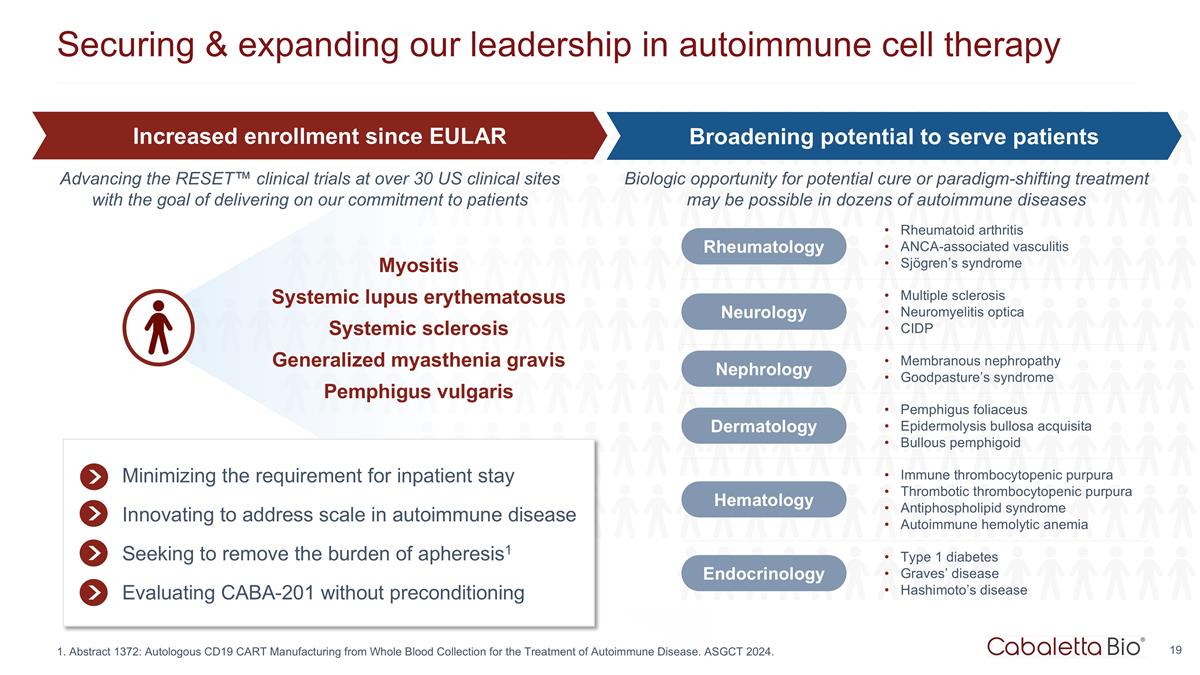
Securing & expanding our
leadership in autoimmune cell therapy Myositis Systemic lupus erythematosus Systemic sclerosis Generalized myasthenia gravis Pemphigus vulgaris Minimizing the requirement for inpatient stay Innovating to address scale in autoimmune disease Seeking
to remove the burden of apheresis1 Evaluating CABA-201 without preconditioning Immune thrombocytopenic purpura Thrombotic thrombocytopenic purpura Antiphospholipid syndrome Autoimmune hemolytic anemia Hematology Type 1 diabetes Graves’ disease
Hashimoto’s disease Endocrinology Rheumatology Rheumatoid arthritis ANCA-associated vasculitis Sjögren’s syndrome Neurology Multiple sclerosis Neuromyelitis optica CIDP Nephrology Membranous nephropathy Goodpasture’s syndrome
Dermatology Pemphigus foliaceus Epidermolysis bullosa acquisita Bullous pemphigoid Increased enrollment since EULAR Broadening potential to serve patients Biologic opportunity for potential cure or paradigm-shifting treatment may be possible in
dozens of autoimmune diseases Advancing the RESET™ clinical trials at over 30 US clinical sites with the goal of delivering on our commitment to patients 1. Abstract 1372: Autologous CD19 CART Manufacturing from Whole Blood Collection for the
Treatment of Autoimmune Disease. ASGCT 2024.
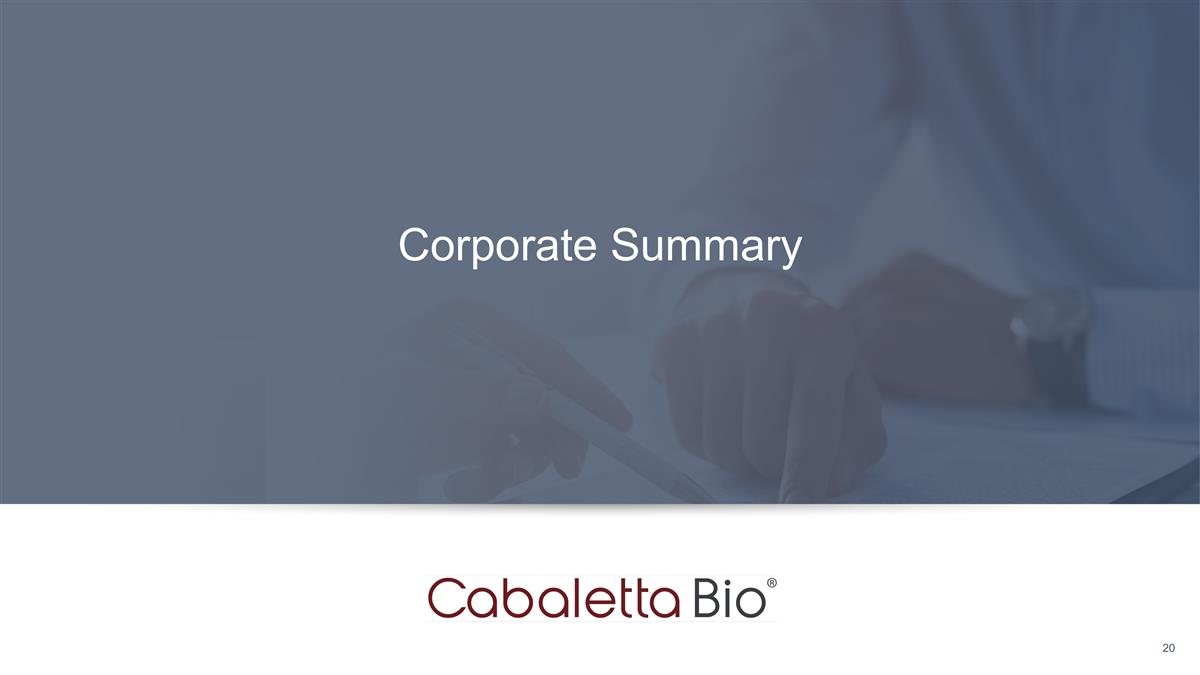
Corporate Summary

Track record of operational success
evaluating novel cell therapy candidates in autoimmunity Cabaletta Bio leadership LEADERSHIP TEAM Anup Marda Chief Financial Officer Martha O’Connor Chief HR Officer Michael Gerard General Counsel Steven Nichtberger, M.D. President, CEO &
Chairman Heather Harte-Hall Chief Compliance Officer Gwendolyn Binder, Ph.D. President, Science & Technology SCIENTIFIC ADVISORY BOARD Aimee Payne, M.D., Ph.D. Co-Founder and Co-Chair Michael C. Milone, M.D., Ph.D. Co-Founder and Co-Chair Carl
June, M.D. Jay Siegel, M.D. Brian Daniels, M.D. Drew Weissman, M.D., Ph.D. Iain McInnes, Ph.D., FRCP, FRSE, FMedSci Georg Schett, M.D. BOARD OF DIRECTORS Steven Nichtberger, M.D. Richard Henriques Scott Brun, M.D. Mark Simon Catherine Bollard, M.D.
Shawn Tomasello David J. Chang, M.D., M.P.H., FACR Chief Medical Officer Samik Basu, M.D. Chief Scientific Officer Arun Das, M.D. Chief Business Officer From Fortune. ©2024 Fortune Media IP Limited. All rights reserved. Used under license.
Sarah Yuan Chief Technology Officer Gerwin Winter Head of International

Realizing the vision to transform
autoimmune disease treatment 1H24: Reported initial myositis & SLE clinical data Securing efficient & scalable commercial manufacturing Advancing whole blood program to replace apheresis Enrolling PV trial of CABA-201 without preconditioning
Cash runway into 1H26 Engineered CABA-201 specifically for use in autoimmune patients Leveraging insights from academic clinical data1 Executing IND specific clinical program to potentially accelerate path to regulatory approval No requirement for
dose escalation Independent, parallel 6-patient cohorts Increased enrollment observed at industry-leading 30+ US clinical sites 2H243: Additional clinical data in myositis & SLE at ACR 2024 Initial clinical data in SSc at ACR 2024 FDA fast track
designation granted for CABA-201 in multiple indications2 SLE – Systemic lupus erythematosus; SSc – Systemic sclerosis; PV – Pemphigus vulgaris; ACR 2024 – American College of Rheumatology 2024 annual meeting from November
14-19, 2024. Müller, Fabian, et al. "CD19 CAR T-Cell Therapy in Autoimmune Disease—A Case Series with Follow-up." New England Journal of Medicine 390.8 (2024): 687-700. The construct utilized in these studies has a similar design to
CABA-201, sharing the 4-1BB costimulatory domain, but is a different construct. FDA Fast Track Designation received in dermatomyositis, SLE, lupus nephritis and systemic sclerosis. Initial clinical data in myasthenia gravis anticipated in 1H25.
Innovations in development

Corporate Presentation OCTOBER
2024
v3.24.3
| X |
- DefinitionBoolean flag that is true when the XBRL content amends previously-filed or accepted submission.
| Name: |
dei_AmendmentFlag |
| Namespace Prefix: |
dei_ |
| Data Type: |
xbrli:booleanItemType |
| Balance Type: |
na |
| Period Type: |
duration |
|
| X |
- DefinitionFor the EDGAR submission types of Form 8-K: the date of the report, the date of the earliest event reported; for the EDGAR submission types of Form N-1A: the filing date; for all other submission types: the end of the reporting or transition period. The format of the date is YYYY-MM-DD.
| Name: |
dei_DocumentPeriodEndDate |
| Namespace Prefix: |
dei_ |
| Data Type: |
xbrli:dateItemType |
| Balance Type: |
na |
| Period Type: |
duration |
|
| X |
- DefinitionThe type of document being provided (such as 10-K, 10-Q, 485BPOS, etc). The document type is limited to the same value as the supporting SEC submission type, or the word 'Other'.
| Name: |
dei_DocumentType |
| Namespace Prefix: |
dei_ |
| Data Type: |
dei:submissionTypeItemType |
| Balance Type: |
na |
| Period Type: |
duration |
|
| X |
- DefinitionAddress Line 1 such as Attn, Building Name, Street Name
| Name: |
dei_EntityAddressAddressLine1 |
| Namespace Prefix: |
dei_ |
| Data Type: |
xbrli:normalizedStringItemType |
| Balance Type: |
na |
| Period Type: |
duration |
|
| X |
- DefinitionAddress Line 2 such as Street or Suite number
| Name: |
dei_EntityAddressAddressLine2 |
| Namespace Prefix: |
dei_ |
| Data Type: |
xbrli:normalizedStringItemType |
| Balance Type: |
na |
| Period Type: |
duration |
|
| X |
- Definition
+ References
+ Details
| Name: |
dei_EntityAddressCityOrTown |
| Namespace Prefix: |
dei_ |
| Data Type: |
xbrli:normalizedStringItemType |
| Balance Type: |
na |
| Period Type: |
duration |
|
| X |
- DefinitionCode for the postal or zip code
| Name: |
dei_EntityAddressPostalZipCode |
| Namespace Prefix: |
dei_ |
| Data Type: |
xbrli:normalizedStringItemType |
| Balance Type: |
na |
| Period Type: |
duration |
|
| X |
- DefinitionName of the state or province.
| Name: |
dei_EntityAddressStateOrProvince |
| Namespace Prefix: |
dei_ |
| Data Type: |
dei:stateOrProvinceItemType |
| Balance Type: |
na |
| Period Type: |
duration |
|
| X |
- DefinitionA unique 10-digit SEC-issued value to identify entities that have filed disclosures with the SEC. It is commonly abbreviated as CIK. Reference 1: http://www.xbrl.org/2003/role/presentationRef
-Publisher SEC
-Name Exchange Act
-Number 240
-Section 12
-Subsection b-2
| Name: |
dei_EntityCentralIndexKey |
| Namespace Prefix: |
dei_ |
| Data Type: |
dei:centralIndexKeyItemType |
| Balance Type: |
na |
| Period Type: |
duration |
|
| X |
- DefinitionIndicate if registrant meets the emerging growth company criteria. Reference 1: http://www.xbrl.org/2003/role/presentationRef
-Publisher SEC
-Name Exchange Act
-Number 240
-Section 12
-Subsection b-2
| Name: |
dei_EntityEmergingGrowthCompany |
| Namespace Prefix: |
dei_ |
| Data Type: |
xbrli:booleanItemType |
| Balance Type: |
na |
| Period Type: |
duration |
|
| X |
- DefinitionCommission file number. The field allows up to 17 characters. The prefix may contain 1-3 digits, the sequence number may contain 1-8 digits, the optional suffix may contain 1-4 characters, and the fields are separated with a hyphen.
| Name: |
dei_EntityFileNumber |
| Namespace Prefix: |
dei_ |
| Data Type: |
dei:fileNumberItemType |
| Balance Type: |
na |
| Period Type: |
duration |
|
| X |
- DefinitionTwo-character EDGAR code representing the state or country of incorporation.
| Name: |
dei_EntityIncorporationStateCountryCode |
| Namespace Prefix: |
dei_ |
| Data Type: |
dei:edgarStateCountryItemType |
| Balance Type: |
na |
| Period Type: |
duration |
|
| X |
- DefinitionThe exact name of the entity filing the report as specified in its charter, which is required by forms filed with the SEC. Reference 1: http://www.xbrl.org/2003/role/presentationRef
-Publisher SEC
-Name Exchange Act
-Number 240
-Section 12
-Subsection b-2
| Name: |
dei_EntityRegistrantName |
| Namespace Prefix: |
dei_ |
| Data Type: |
xbrli:normalizedStringItemType |
| Balance Type: |
na |
| Period Type: |
duration |
|
| X |
- DefinitionThe Tax Identification Number (TIN), also known as an Employer Identification Number (EIN), is a unique 9-digit value assigned by the IRS. Reference 1: http://www.xbrl.org/2003/role/presentationRef
-Publisher SEC
-Name Exchange Act
-Number 240
-Section 12
-Subsection b-2
| Name: |
dei_EntityTaxIdentificationNumber |
| Namespace Prefix: |
dei_ |
| Data Type: |
dei:employerIdItemType |
| Balance Type: |
na |
| Period Type: |
duration |
|
| X |
- DefinitionLocal phone number for entity.
| Name: |
dei_LocalPhoneNumber |
| Namespace Prefix: |
dei_ |
| Data Type: |
xbrli:normalizedStringItemType |
| Balance Type: |
na |
| Period Type: |
duration |
|
| X |
- DefinitionBoolean flag that is true when the Form 8-K filing is intended to satisfy the filing obligation of the registrant as pre-commencement communications pursuant to Rule 13e-4(c) under the Exchange Act. Reference 1: http://www.xbrl.org/2003/role/presentationRef
-Publisher SEC
-Name Exchange Act
-Number 240
-Section 13e
-Subsection 4c
| Name: |
dei_PreCommencementIssuerTenderOffer |
| Namespace Prefix: |
dei_ |
| Data Type: |
xbrli:booleanItemType |
| Balance Type: |
na |
| Period Type: |
duration |
|
| X |
- DefinitionBoolean flag that is true when the Form 8-K filing is intended to satisfy the filing obligation of the registrant as pre-commencement communications pursuant to Rule 14d-2(b) under the Exchange Act. Reference 1: http://www.xbrl.org/2003/role/presentationRef
-Publisher SEC
-Name Exchange Act
-Number 240
-Section 14d
-Subsection 2b
| Name: |
dei_PreCommencementTenderOffer |
| Namespace Prefix: |
dei_ |
| Data Type: |
xbrli:booleanItemType |
| Balance Type: |
na |
| Period Type: |
duration |
|
| X |
- DefinitionTitle of a 12(b) registered security. Reference 1: http://www.xbrl.org/2003/role/presentationRef
-Publisher SEC
-Name Exchange Act
-Number 240
-Section 12
-Subsection b
| Name: |
dei_Security12bTitle |
| Namespace Prefix: |
dei_ |
| Data Type: |
dei:securityTitleItemType |
| Balance Type: |
na |
| Period Type: |
duration |
|
| X |
- DefinitionName of the Exchange on which a security is registered. Reference 1: http://www.xbrl.org/2003/role/presentationRef
-Publisher SEC
-Name Exchange Act
-Number 240
-Section 12
-Subsection d1-1
| Name: |
dei_SecurityExchangeName |
| Namespace Prefix: |
dei_ |
| Data Type: |
dei:edgarExchangeCodeItemType |
| Balance Type: |
na |
| Period Type: |
duration |
|
| X |
- DefinitionBoolean flag that is true when the Form 8-K filing is intended to satisfy the filing obligation of the registrant as soliciting material pursuant to Rule 14a-12 under the Exchange Act. Reference 1: http://www.xbrl.org/2003/role/presentationRef
-Publisher SEC
-Name Exchange Act
-Section 14a
-Number 240
-Subsection 12
| Name: |
dei_SolicitingMaterial |
| Namespace Prefix: |
dei_ |
| Data Type: |
xbrli:booleanItemType |
| Balance Type: |
na |
| Period Type: |
duration |
|
| X |
- DefinitionTrading symbol of an instrument as listed on an exchange.
| Name: |
dei_TradingSymbol |
| Namespace Prefix: |
dei_ |
| Data Type: |
dei:tradingSymbolItemType |
| Balance Type: |
na |
| Period Type: |
duration |
|
| X |
- DefinitionBoolean flag that is true when the Form 8-K filing is intended to satisfy the filing obligation of the registrant as written communications pursuant to Rule 425 under the Securities Act. Reference 1: http://www.xbrl.org/2003/role/presentationRef
-Publisher SEC
-Name Securities Act
-Number 230
-Section 425
| Name: |
dei_WrittenCommunications |
| Namespace Prefix: |
dei_ |
| Data Type: |
xbrli:booleanItemType |
| Balance Type: |
na |
| Period Type: |
duration |
|
Cabaletta Bio (NASDAQ:CABA)
過去 株価チャート
から 10 2024 まで 11 2024

Cabaletta Bio (NASDAQ:CABA)
過去 株価チャート
から 11 2023 まで 11 2024
